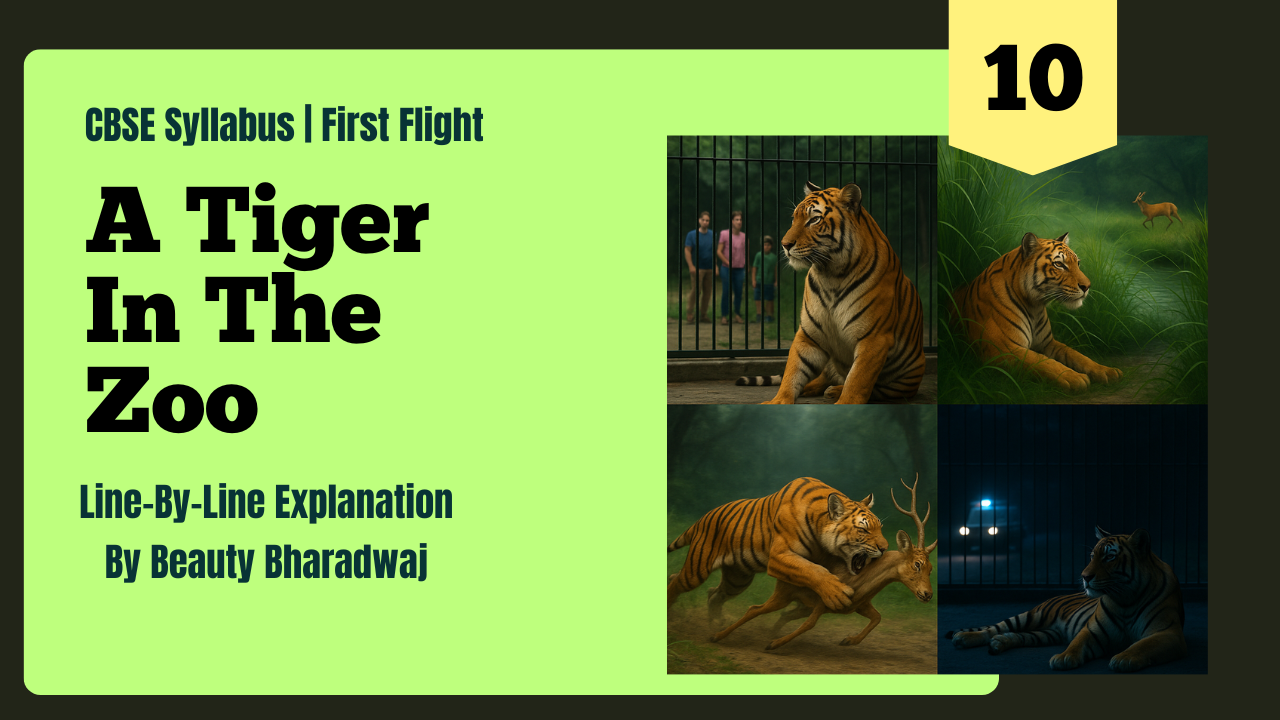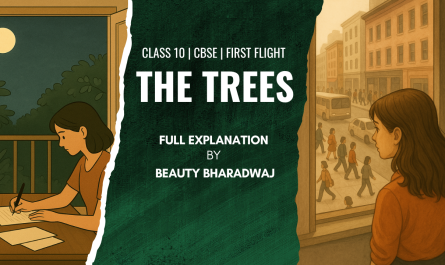Explanation | Summary | Poetic Devices | Main Themes | Class 10 CBSE Syllabus | First Flight
Short Summary of the Poem
The poem A Tiger in the Zoo by Leslie Norris shows the sharp contrast between a tiger’s life in the wild and in captivity.
In the zoo, the tiger moves helplessly inside a small cage, taking only a few steps. His soft paws make no sound, but his anger and frustration are hidden inside. He ignores the visitors and his strength lies wasted behind the bars. At night, he only hears the sound of patrol cars and stares at the shining stars, feeling lonely and powerless.
In the jungle, however, the tiger would have been free — hiding in tall grass near a waterhole to hunt deer, or roaming near villages, showing his sharp teeth and claws, and creating fear among people.
The poet highlights the cruelty of captivity. A creature known for freedom and fearlessness is reduced to helplessness in a cage. The poem conveys a strong message against keeping wild animals locked up for human entertainment.
For a detailed explanation of the poem The Power of Music and other poems of class 9 and 10 ICSE Syllabus, go to my channel, Beauty Bharadwaj.

Main Theme of the Poem
This poem compares the life of a tiger in the zoo with that of a tiger in the jungle. The poem first shows the tiger in the zoo, then in the jungle, and then again back in the zoo. In the zoo, the tiger has no freedom. He is locked inside a cement cage behind iron bars. There he feels anger, frustration, and helplessness.
The poet says that if the tiger were free, he would hide behind tall grass near the water and wait for his prey, or he would frighten villagers by showing his sharp teeth and claws. But in reality, at night in the zoo, he only hears the sound of patrolling cars.
The tiger in the zoo has become nothing more than a showpiece for people’s entertainment. Through this poem, the poet wants to convey that keeping wild animals in small cages is very cruel because their true home is the jungle, their natural habitat. In the cage, the tiger feels only anger, sadness, and helplessness. He pays no attention to the visitors; instead, in the silence of the night, he simply looks at the stars with his bright eyes.
Poetic Devices used in the Poem
- Personification: In this poem tiger has been personified because here tiger has been referred as “he” not “it”.
2. Metaphor – The paws of a tiger have been compared with velvet.
3. Enjambment: This is the lietrary device where there is no punctuation mark at the end of the sentence.
4. Imagery : The poetic device where vivid description is given so that it forms a picture in the mind of the readers. For example, He stalks in his vivid stripes.
5. Assonance: The poetic device where similar vowel sounds are repeated. For Example, in the lines
– He stalks in his vivid stripes, i sound is repeated.
– In his quiet rage, i sound is repeated.
6. Consonance : The poetic device where similar consonant sounds are repeated.
For Example, in the line- Stalks in his vivid stripes. ‘s’ sound. Plump Pass– ‘p’ sound
7. Oxymoron : It is used when two contradictory or opposite ideas/words are placed together to create a poetic or dramatic effect. For example, quiet rage.
8. Synecdoche : It refers to a literary device in which a part of something is substituted for the whole.
Example – Here, the poet has used the phrase vivid stripes for the whole body of the tiger.
Line-by-line explanation of the Poem
Stanza 1
He stalks in his vivid stripes
The few steps of his cage,
On pads of velvet, quiet,
In his quiet rage.
Explanation
The rhyme scheme of the poem is ABAB. The poet says that the tiger, with his bright stripes, can take only a few steps inside the small cage. His soft, velvet-like paws make no sound, but inside he is full of anger and frustration.
This “quiet rage” shows his helplessness — the king of the jungle is now reduced to just moving restlessly within the cage.
Think of it this way: a tiger’s roar can shake the entire forest, but here he can only walk 5–6 steps in his cage. It is like being given a whole playground where you can play cricket or football, but then suddenly being forced to sit in a small corner of the classroom. You would only be able to move around that corner, right? That is exactly the tiger’s situation.
Stanza 2
He should be lurking in shadow,
Sliding through long grass
Near the water hole
Where plump deer pass.
Explanation
The poet imagines that if the tiger were free in the jungle, he would hide behind tall grass, quietly waiting for his prey. The word lurking means hiding secretly.
He would stay near the waterhole, where strong, healthy deer come to drink water. In other words, the natural hunting life of the tiger has been taken away from him because of the zoo’s cage.

Stanza 3
He should be snarling around houses
At the jungle’s edge,
Baring his white fangs, his claws,
Terrorising the village!
Explanation
The poet says that if the tiger were in the jungle, he would roam around the edge of the village, frightening people by showing his sharp teeth and claws. While he is completely helpless in the cage, in the wild his mere presence would be enough to terrify the villagers.
This shows the clear difference — in the jungle, the tiger inspires fear, but in the cage, he can only take a few steps and even ignores the visitors who come to see him.

Stanza 4
But he’s locked in a concrete cell,
His strength behind bars,
Stalking the length of his cage,
Ignoring visitors.
Explanation
Now the poet brings us back to reality — the tiger is locked inside a strong concrete cage. His strength and fierceness are now trapped behind the bars.
He keeps walking inside the cage and ignores the visitors because he can no longer scare them.

Stanza 5
He hears the last voice at night,
The patrolling cars,
And stares with his brilliant eyes
At the brilliant stars.
Explanation
At night, the tiger only hears the sound of police patrol cars. Instead of living freely under the open sky of the jungle, he now just looks at the stars from his cage.
His bright, shining eyes now reflect only helplessness and sadness. This stanza gives us the most emotional picture of his loneliness and captivity.




